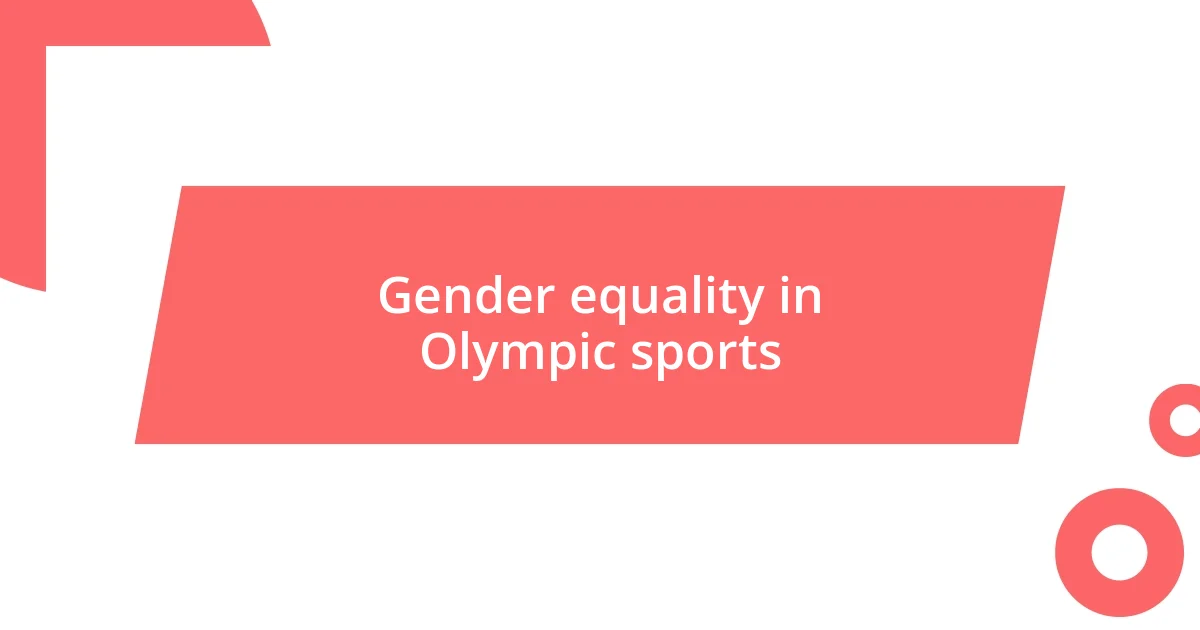Key takeaways:
- The Olympics originated in ancient Greece in 776 BC and evolved into a modern international spectacle with the revival in 1896, showcasing global athleticism.
- Technological advancements, such as wearable tech and virtual reality, have transformed training, performance analysis, and fan engagement in Olympic sports.
- Progress toward gender equality has been significant, yet disparities in funding and opportunities for female athletes remain, necessitating collective efforts for true equality.

Historical timeline of Olympics
The journey of the Olympics began in ancient Greece in 776 BC, a time when city-states would gather to celebrate athletic excellence. I often find myself imagining the excitement in Olympia as athletes competed in events like running, wrestling, and chariot racing. Doesn’t it make you wonder how the spirit of competition has persisted through centuries?
Fast forward to 1896, the modern Olympic Games kicked off in Athens, reigniting the flame of athletic camaraderie. This revival, led by Pierre de Coubertin, marked a shift from a local celebration to an international spectacle. I remember reading about how athletes from 13 nations participated; it was thrilling to think about just how bold that step was toward global unity.
By 1960, the Games had expanded even further, not just in the number of sports but in their cultural significance, showcasing athletes like Cassius Clay, who later became Muhammad Ali. This era was marked by convictions and protests, reflecting a world grappling with social change. As I reflect on that time, I can’t help but feel a deep sense of admiration for those who used the platform of the Olympics to voice their beliefs.

Changing sports in the Olympics
The landscape of Olympic sports has transformed significantly over the years, reflecting broader social changes and the evolving interests of global audiences. I recall the surprise and excitement I felt when skateboarding and surfing made their debut in Tokyo 2020. It brought a fresh energy to the Games and resonated with a younger demographic, highlighting the necessity for the Olympics to stay relevant in our fast-paced world.
- New sports are regularly introduced to attract a diverse audience.
- Traditional events continue to adapt, with advancements in training and technology.
- The inclusion of mixed-gender events promotes equality and broader participation.
As I delve deeper into this topic, I recognize how crucial it is for the Olympics to evolve. I’ve watched young athletes chase their dreams in sports that didn’t even exist in past decades. This shift not only broadens the competitive platform but also celebrates the varied expressions of athleticism. It’s fascinating to think about how each new sport adds a layer of richness to the Olympic tapestry, telling a new story with each iteration of the Games.

Impact of technology on sports
The role of technology in sports has been nothing short of revolutionary. I vividly remember watching the 2008 Beijing Olympics, where the introduction of high-speed cameras showcased not only the precision of athletes but also the intricate details of their form and technique in ways I’d never seen before. It made me realize that technology doesn’t just change how we watch events; it fundamentally alters the coaching and training processes, too.
In my experience, the application of wearable technology—like heart rate monitors and GPS trackers—has made a world of difference. Coaches and athletes can now analyze performance in real-time, tailoring training programs to individual needs. This personal approach, driven by data, is something I find tremendously exciting. Have you ever thought about how much easier it must be for athletes now to track their progress and optimize their performance? I often wonder what past champions would think of such advancements.
Even the viewing experience has evolved dramatically due to technology. The integration of virtual reality and augmented reality allows fans to immerse themselves in the action, experiencing competitions almost like being on-site. I once put on a VR headset to “attend” a live event, and it truly felt like I was in the middle of the crowd, cheering alongside thousands. These innovations not only enhance fan engagement but also create new opportunities for sports marketing and broadcasting.
| Technology | Impact on Sports |
|---|---|
| High-speed cameras | Enhanced training analysis and viewer experience |
| Wearable technology | Real-time performance tracking for personalized training |
| Virtual and augmented reality | Immersive fan experiences and new marketing avenues |

Evolution of athlete training methods
The evolution of athlete training methods has been profound, shifting dramatically from traditional techniques to a more scientific approach. Reflecting on my own experience, I remember the days when athletes relied heavily on trial and error, often training based on instinct rather than data. With the emergence of sports science, methods have become more systematic, blending physiological insights with psychological strategies to enhance performance.
In training sessions today, I’ve seen how coaches utilize video analysis to break down movements and refine techniques. It’s fascinating to watch athletes analyze their performance frame-by-frame, identifying those tiny, yet impactful adjustments that earlier generations could only guess at. Can you imagine the advantage this gives them during competitions? Personally, it’s invigorating to witness the level of precision training has now reached, where even the slightest tweak can lead to a medal-winning performance.
Moreover, the incorporation of mental conditioning has reshaped training. I distinctly remember a conversation with a coach who shared how they now prioritize mental resilience as much as physical strength. They use visualization techniques and mindfulness exercises to help athletes cope with pressure. This holistic approach not only prepares athletes for the physical demands of their sport but also for the psychological battles that can emerge on the biggest stages. Isn’t it incredible how much the landscape of athlete training has evolved? Each of these changes not only reflects a deeper understanding of human potential but also paves the way for future generations to break even more records.

Gender equality in Olympic sports
Gender equality in Olympic sports has been a journey of both struggle and triumph. I remember watching the 2012 London Olympics, where women competed in every event for the first time. It struck me how such moments define progress—not just for the athletes but for women all around the world who see representation and possibility in these games. How inspiring it must be for young girls to witness their potential on such a grand stage!
Yet, we cannot overlook the ongoing disparities that still exist. There are considerable gaps in funding, coverage, and opportunities for female athletes compared to their male counterparts. Reflecting on this, I often wonder how many incredible stories have gone untold simply due to lack of media attention. Achieving true equality means amplifying these voices and celebrating the achievements that deserve the spotlight.
In my perspective, creating an environment that fosters gender equality necessitates collective effort. It’s not just about staging events but ensuring equal resources, coaching, and support. I’ve seen firsthand how powerful it is when organizations actively work to bridge these gaps—an inspiring move that encourages both male and female athletes to excel side by side. Isn’t it imperative for all of us to advocate for this change? The future of Olympic sports hinges on equality, and it’s a journey we must all embrace together.

Future trends in Olympic sports
As I look ahead to the future of Olympic sports, one trend that really excites me is the continued integration of technology into athletic performance. It’s almost surreal to think about wearable devices that can measure heart rates or fatigue levels in real-time, allowing athletes to adjust their performance on the fly. I recall a time when decisions were often made based on gut feelings, but now, these insights can lead to better outcomes on the field or track. How fascinating will it be to see athletes leverage this information to push the boundaries of how we measure success?
Moreover, the push for sustainability is undeniably reshaping the Olympic landscape. I remember attending a conference where someone highlighted how eco-friendly materials and energy-efficient venues were becoming essential for future games. It got me thinking: as we embrace greener practices, how will this influence not just the infrastructure, but also athlete training and overall attitudes toward competition? The idea that athletes can compete while advocating for the planet is truly powerful and speaks to a broader purpose beyond just medals.
Lastly, the inclusion of new sports is something that creates buzz and excitement. I’ve seen how the addition of sports like skateboarding and sport climbing at recent Olympics has appealed to younger audiences. Isn’t it fascinating how these fresh additions can revitalize traditions? Personally, witnessing the energy these sports bring to the Games makes me optimistic about the future—imagine what the next lineup will look like! This evolving landscape means more than just variety; it captures the spirit of the times and keeps the Olympics relevant in an ever-changing world.

Lessons from Olympic sports evolution
One significant lesson I’ve drawn from the evolution of Olympic sports is the importance of adaptability. I vividly remember the transition to more inclusive events, where para-athletes began to share the spotlight with their able-bodied counterparts. It was eye-opening to see how these adjustments not only elevated the competition but also encouraged a broader understanding of what athletic excellence looks like. Doesn’t it make you appreciate the strength it takes to adapt to new norms and celebrate diversity in sports?
Additionally, the ongoing dialogue surrounding mental health in athletics has changed the Olympic narrative profoundly. When I watched elite athletes openly discuss their struggles, it felt like a watershed moment. They’re showing that vulnerability is not a weakness; it’s part of being human. Reflecting on their courage, I wonder how many young athletes feel empowered to voice their own challenges, knowing they’re not alone in their journey?
Lastly, the rise of community engagement through Olympic events has really struck a chord with me. Attending local viewing parties, I’ve seen firsthand how these gatherings foster connections and ignite passion for sports beyond just the competition itself. It leads me to consider: how can we continue to harness that excitement to inspire our youth? Building community around Olympic values creates a lasting legacy that transcends the games, doesn’t it?














